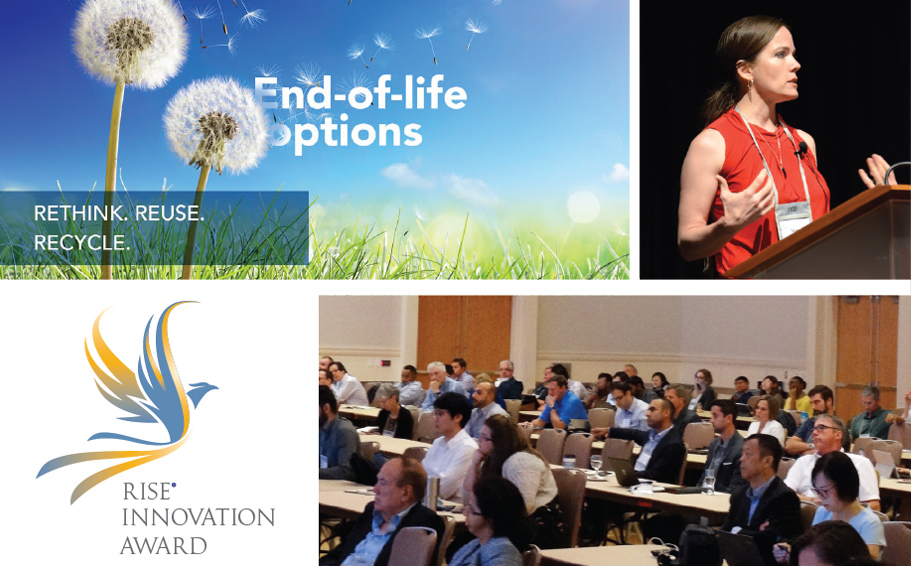
RISE 2017 announces expanded programme
Emphasis on natural and bio-based alternatives to synthetics in North Carolina.
18th August 2022
Innovation in Textiles
|
Cary, NC, USA
More than 20 industry experts will present their views on how material science innovations can create a more sustainable future for the nonwovens industry at INDA’s 12th Research, Innovation and Science for Engineered Fabrics (RISE) conference, taking place from September 27-28 at North Carolina State University.
RISE will focus on rethinking, reusing and recycling nonwovens and engineered materials – from the responsible sourcing of nonwoven inputs to developing realistic end-of-life options and circularity.
BOTTLE
Among key speakers, Kat Knauer, of the US Research, National Renewable Energy Laboratory (NREL) will explain the objectives of BOTTLE – Bio-Optimised Technologies to keep Thermoplastics out of Landfills and the Environment – a US Department of Energy multi-organisation consortium developing new upcycling strategies for today’s plastics to achieve a circular supply chain.
BOTTLE is conducting research using techno-economic and life-cycle analysis to identify optimum solutions and aiming to redefine circularity by implementing upcycling paradigms. The goal is to break down the walls between mechanical, chemical and biological processes and combine innovations to achieve the most efficient and economical pathways for waste management, and also to redesign plastics with built in recyclability.
Behnam Pourdeyhimi, executive director of The Nonwovens Institute at North Carolina State University will outline the opportunities for new materials based on PLA and PLA blends with other biopolymers and also highlight the practical aspects of fibre extrusion with an emphasis on filament extrusion and spunbonding.
Southeast Nonwovens (SENW), based in Clover, South Carolina, has previously done a lot of work with hemp and cotton-based nonwovens and at RISE, the company’s director of research and development Paul Latten will explore the use of other natural fibres as potential raw materials.
The company has been working on the wetlaying and carding of banana, bagasse, sisal, seaweed, coconut, pineapple and flax and the key issues and opportunities for them as ingredients in sustainable nonwovens will be outlined.
Olaf Isele, strategic product development director, at Trace Femcare, will also detail his company’s work with hemp as a fibre for absorbent hygiene products.
Quats
Doug Hinchliffe a research molecular biologist at the USDA Agricultural Research Service in New Orleans, will detail work on expanding the use of cotton in nonwovens through the development of new and improved products, processes and applications.
His team is exploring several approaches to mitigate the depletion of quats – qauaternary ammonium compounds – from bulk solution onto cellulosic materials.
Quats are cationic surfactants widely used as the active antimicrobial ingredient for disposable disinfecting wipes. The cationic nature of quats results in a strong electrostatic interaction and adsorption onto wipes materials that have an anionic surface charge, such as cotton and other cellulosic materials. This can effectively deplete quats from bulk solution and reduce their deposition onto a hard surface, thereby reducing antimicrobial efficacy.
Quat co-formulations that minimise electrostatic interactions, surface modifications that result in cationic cellulosic substrates and substrate surface area reduction using coarse staple fibres are all being researched and preliminary efficacy testing results required for the EPA registration of disposable disinfecting wipes will be discussed.

Finishes
Fibre and web finishes to enhance both processing and product performance will be presented by Kay McCoy, technical sales representative for Pulcra Chemicals.
Finishes are typically applied to a level of less than 1% weight of the fibre and can be tailored to specific functions such as hydrophilic and hydrophobic characteristics, wicking, soft hand, skin health and disinfectant interaction.
The parameters that can be varied to develop the optimum finish for end product performance will be explained to provide a working knowledge of finish development as a reference for new product development projects and the difference in finish requirements for natural fibres compared to synthetics will also be detailed.
Finish development is also significantly directed by regulatory requirements and some of the considerations in finish formulation and the development of renewable finish components will also be discussed.
Stereochemistry
Matthew Becker of Duke University will describe work on stereochemistry in order to toughen sugar-based polymers and degradable elastomers.
Stereochemistry in polymers can be used as an effective tool to control the mechanical and physical properties of the resulting materials. Typically, in synthetic polymers, differences among polymer stereoisomers leads to incremental property variation, such as no changes to the baseline plastic or elastic behaviour.
The stereochemical differences in sugar-based monomers yields a family of non-segmented, alternating polyurethanes that can be either strong amorphous thermoplastic elastomers with properties that exceed most cross-linked rubbers, or robust, semicrystalline thermoplastics with properties comparable to commercial plastics.
The stereochemical differences in the monomers direct distinct intra- and interchain supramolecular hydrogen-bonding interactions in the bulk materials to define their behaviour. The chemical similarity among these isohexide-based polymers enables both statistical copolymerization and blending, which each afford independent control over degradability and mechanical properties. The modular molecular design of the polymers provides an opportunity to create a family of materials with divergent properties that possess inherently built degradability and outstanding mechanical performance.
SUPD
The Single Use Plastics Directive (SUPD) was a wake-up call to the nonwovens industry in several respects, according to Bryan Haynes, senior technical director of global nonwovens at Kimberly-Clark.
“First, the industry was not sufficiently prepared to prove the benefits of bioplastics relative to biodegradability and microplastics and secondly, many of the potential solutions, including circularity, are longer term in nature, but we need solutions now,” he says.
His paper will provide an update on Kimberly-Clark’s sustainability journey and break down some of the problems that need immediate solutions.
BioBlends
In the last couple of decades, researchers all over the world have attempted to develop thermoplastic starch for many applications, but have been hampered by difficulties including poor mechanical strength, according to Steven Sherman, CEO, BioLogiQ, Inc.
Researchers at BioLogiQ have developed a proprietary thermal gelatinization process in the presence of plasticizers, via which a low-cost thermoplastic starch material with superior mechanical properties can be made, in pellet form. The starch pellets, though brittle in nature, are100% bio based and can be conveniently blended with partner fossil fuel-based resins, or with biopolymers to create what the company calls BioBlends. Articles made using these BioBlends exhibit either similar or superior mechanical properties compared to the articles made with 100% resins.
More interestingly, in many cases applications using these BioBlends exhibit exciting biodegradation properties without fragmentation, resulting in significantly reduced microplastics and complete biodegradation of the starch and the partner resin. Researchers at BioLogiQ are also actively working on using these BioBlends made from PP and starch in nonwoven applications, providing a pathway for bio content, reduced microplastics, and biodegradation. Some salient features of the BioBlends, the mechanical properties of the films made using them and the results of biodegradation studies will be presented.
Heidi Beatty, CEO of Crown Abbey will meanwhile introduce an alternative source of cellulosic raw material, not derived from trees, but by the fermentation of agricultural by-products and wastes. She will also discuss some of the properties of this ‘microbial cellulose’ and the regenerated cellulosic fibres derived from it.
Markets
In looking at the markets, economist Robert Fry, will provide his outlook on the global economy, with an emphasis on the United States and on what leading indicators are telling us about the near-term risks of a US recession. Among the topics covered will be gross domestic product, industrial production, labour markets, housing starts, vehicle sales, inflation and interest rates.
Brad Kalil, INDA’s director of market intelligence and economic insights, will further discuss the market changes in demand and supply as the North American nonwovens industry responded, and still responds, to the Covid-19 crisis. Specifically, the presentation will present a pre-pandemic view of the nonwovens markets, the current state, and a look into the future. The future outlook will incorporate both demand possibilities and supply reactions, particularly new capacities coming to alleviate shortages in some of the markets.
In the last five-years, 115 lines have started in North America. Going forward there has been a significant amount of publicly announced nonwoven investment. In a typical year less than $100 million is publicly announced. In the 2020-21 period $278 million was announced and in the 2022-23 period $611 million has been publicly announced. The implications of this will be fully explored.
The event also will also feature the presentation of the RISE Innovation Award, a special opportunity to tour the Nonwovens Institute’s state-of-the-art facilities with advance registration required, and poster presentations by North Carolina State University graduate students.

Business intelligence for the fibre, textiles and apparel industries: technologies, innovations, markets, investments, trade policy, sourcing, strategy...
Find out more